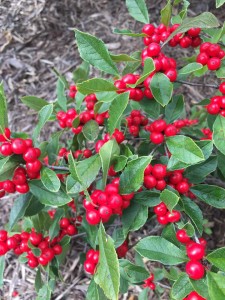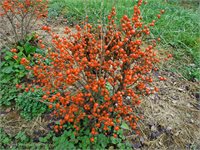Little Goblin® Red (Ilex verticillata ‘NCIV1’) is one of the new creation from plant breeder Dr. Tom Ranney, at the North Carolina Research And Extension Center in Mills River, NC. It is the first ever tetraploid winterberry. This dwarf variety is also exceptionally hardy and easy to care for.
Little Goblin® Orange (‘NCIV2’) is extremely early flowering and early fruiting winterberry holly produces abundant bright orange berries on a 3-4 feet tall and wide plant. This compact variety is ideal for residential landscapes. It makes an excellent specimen, mass planting, or row beside a driveway or walking path. The berry-laden branches also make beautiful cuts for arrangements!
It thrives in a wide variety of conditions, including almost any soil type, preferably acidic, and climate. It loves moist (even wet) soil, and stands up to hot summers and cold winters with equal resilience (USDA hardiness zones 3 to 9). Plant in a sunny open location for best viewing. This holly series is moderately shaden tolerant, although flower and fruit numbers may be lower. Hollies established after one year are very drought tolerant.
This first ever tetraploid winterberry brings you extra big and abundant rich-red (or orange) berries on a dwarf plant. You will treasure this plant for gardens, mass plantings or as a cut branch. Its compact size makes it ideal for residential landscapes. Prune annually at start of spring to maintain desired height and plant symmetry. Feed plant(s) at planting and in late winter with granular 10-10-10 or an equivalent fertilizer. NOTE: for the best fruiting, set a male pollinator (like Mr. Poppins™) nearby.
Little Goblin holly series is uniquely prolific, with a smaller form that is positively bursting with berries, the red or orange fruits overshadowing the leaves and creating a welcoming sight for most songbirds over a cold winter.



 Posted in
Posted in 
